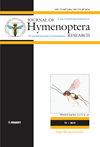马德拉岛三种新的外来蚂蚁(膜翅目、蚁科)及其蚁类的评价
IF 1.5
3区 农林科学
Q2 ENTOMOLOGY
引用次数: 1
摘要
马德拉岛上记录了三种新的外来蚂蚁:Cardiocondia obscurior Wheeler,1929,Lepisiota capensis(Mayr,1862)和Pheidole navigans Forel,1901。众所周知的入侵性巨头象现在在马德拉岛上很少见,可能是因为与导航P.navigans的竞争。我们没有遇到阿根廷蚂蚁——Linepithema humile,这在丰沙尔地区曾经很常见。尽管进行了广泛的搜索,但被认为是地方性的沃拉斯托尼胸蛛(Donisthorpe,1940)除了类型材料外,仍然未知。入侵和外来蚂蚁的存在、丰度和灭绝是动态过程,我们强调持续采样的重要性。本文章由计算机程序翻译,如有差异,请以英文原文为准。
Three new exotic species of ants (Hymenoptera, Formicidae) for Madeira, with comments on its myrmecofauna
Three new exotic species of ants are recorded for the Macaronesian island of Madeira: Cardiocondyla obscurior Wheeler, 1929, Lepisiota capensis (Mayr, 1862) and Pheidole navigans Forel, 1901. The well-known invasive Pheidole megacephala is now rare on Madeira, possibly because of competition with P. navigans. We did not come across the Argentine ant – Linepithema humile, which was once very common in the Funchal area. Despite extensive searching, the presumed endemic Temnothorax wollastoni (Donisthorpe, 1940) remains unknown other than from the type material. Presence, abundance and extinction of invasive and exotic ants are dynamic processes and we stress the importance of continuous sampling.
求助全文
通过发布文献求助,成功后即可免费获取论文全文。
去求助
来源期刊
CiteScore
2.60
自引率
15.40%
发文量
68
审稿时长
>12 weeks
期刊介绍:
The Journal of Hymenoptera Research is a peer-reviewed, open-access, rapid online journal launched to accelerate research on all aspects of Hymenoptera, including biology, behavior, ecology, systematics, taxonomy, genetics, and morphology.
All published papers can be freely copied, downloaded, printed and distributed at no charge for the reader. Authors are thus encouraged to post the pdf files of published papers on their homepages or elsewhere to expedite distribution. There is no charge for color.

 求助内容:
求助内容: 应助结果提醒方式:
应助结果提醒方式:


